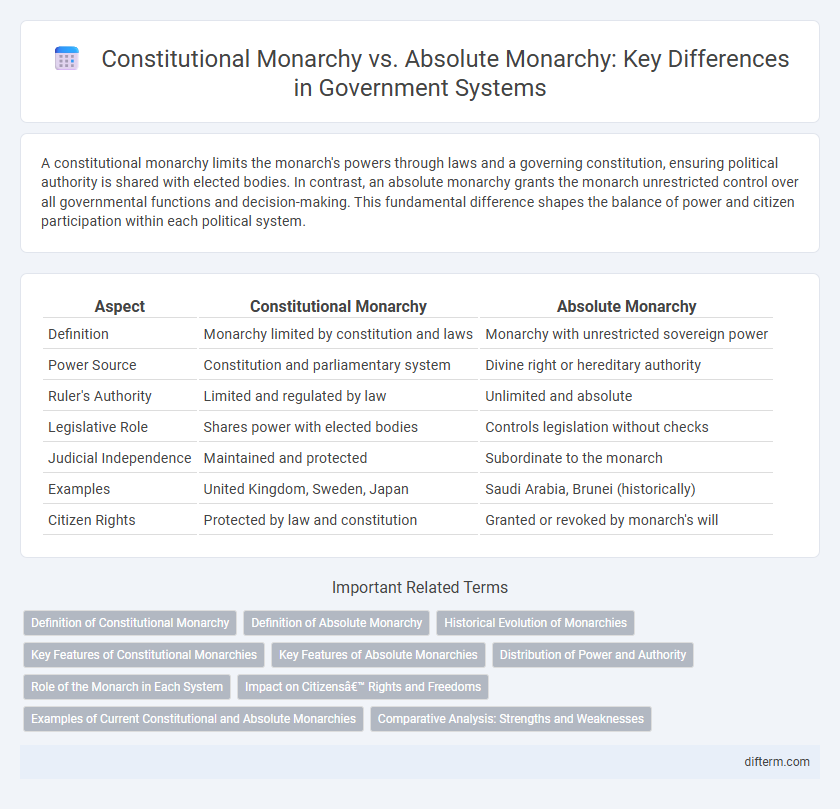A constitutional monarchy limits the monarch's powers through laws and a governing constitution, ensuring political authority is shared with elected bodies. In contrast, an absolute monarchy grants the monarch unrestricted control over all governmental functions and decision-making. This fundamental difference shapes the balance of power and citizen participation within each political system.
Table of Comparison
| Aspect | Constitutional Monarchy | Absolute Monarchy |
|---|---|---|
| Definition | Monarchy limited by constitution and laws | Monarchy with unrestricted sovereign power |
| Power Source | Constitution and parliamentary system | Divine right or hereditary authority |
| Ruler's Authority | Limited and regulated by law | Unlimited and absolute |
| Legislative Role | Shares power with elected bodies | Controls legislation without checks |
| Judicial Independence | Maintained and protected | Subordinate to the monarch |
| Examples | United Kingdom, Sweden, Japan | Saudi Arabia, Brunei (historically) |
| Citizen Rights | Protected by law and constitution | Granted or revoked by monarch's will |
Definition of Constitutional Monarchy
A constitutional monarchy is a system of government in which the monarch's powers are limited and regulated by a constitution or legal framework, ensuring the rule of law and separation of powers. Unlike an absolute monarchy, where the ruler holds unrestricted authority, a constitutional monarchy often features a parliamentary system and protects citizens' rights through codified laws. Prominent examples include the United Kingdom, Sweden, and Japan, where the monarch serves as a ceremonial head of state within a democratic governance structure.
Definition of Absolute Monarchy
Absolute monarchy is a form of government where the monarch holds supreme autocratic authority, unrestricted by laws, constitutions, or political bodies. Unlike constitutional monarchy, where the monarch's powers are limited by legal frameworks and shared with elected officials, an absolute monarch wields centralized control over legislation, judiciary, and administration. Historical examples of absolute monarchies include Louis XIV of France and Tsar Nicholas II of Russia, illustrating concentrated sovereign power without constitutional constraints.
Historical Evolution of Monarchies
Constitutional monarchy emerged in the 17th century, exemplified by the English Bill of Rights in 1689, which significantly curtailed royal authority and established parliamentary sovereignty. This system contrasts with absolute monarchy, epitomized by Louis XIV of France in the 17th century, where the monarch held unrestricted power justified by divine right. Over time, constitutional monarchies evolved to balance power between the crown and elected bodies, reflecting shifts toward democratic governance and legal accountability.
Key Features of Constitutional Monarchies
Constitutional monarchies feature a legal framework that limits the monarch's powers, often outlined in a constitution or similar legal document. The monarch acts as a ceremonial head of state, while elected bodies or officials hold actual governing authority and create laws. This system ensures the protection of citizens' rights and promotes political stability by balancing tradition with democratic governance.
Key Features of Absolute Monarchies
Absolute monarchies concentrate supreme authority in a single ruler whose powers are unlimited by constitutional laws or legislative bodies. The monarch controls the government, military, and legal systems, often justified by the divine right of kings. Unlike constitutional monarchies, where a constitution or parliament limits royal powers, absolute monarchies centralize decision-making and minimize political pluralism.
Distribution of Power and Authority
In a constitutional monarchy, power and authority are distributed between the monarch and an elected or appointed governing body, with the constitution serving as the supreme legal framework limiting the monarch's powers. In contrast, an absolute monarchy centralizes all power in the monarch, who exercises unrestricted control over the government, laws, and policies without constitutional constraints. The balance of power in a constitutional monarchy promotes checks and balances, whereas absolute monarchy consolidates authority solely in the sovereign.
Role of the Monarch in Each System
In a constitutional monarchy, the monarch's role is largely ceremonial, with real political power vested in elected bodies and governed by constitutional laws that limit royal authority. In contrast, an absolute monarchy grants the monarch unchecked power, allowing them to make laws, levy taxes, and govern without legal or institutional restraint. This fundamental difference shapes the governance, legal framework, and political dynamics within each system.
Impact on Citizens’ Rights and Freedoms
Constitutional monarchies limit the monarch's powers through legal frameworks, ensuring citizens enjoy protected rights and freedoms such as freedom of speech, voting, and assembly. Absolute monarchies concentrate power solely in the monarch, often leading to restricted civil liberties and limited political participation for citizens. Historical examples demonstrate constitutional monarchies foster accountability and rule of law, while absolute systems risk arbitrary governance and human rights abuses.
Examples of Current Constitutional and Absolute Monarchies
Current constitutional monarchies include the United Kingdom, Sweden, and Japan, where monarchs serve as ceremonial heads of state within a framework of democratic governance. Absolute monarchies such as Saudi Arabia and Brunei feature rulers with unrestricted political power and limited or no constitutional constraints. These examples highlight the contrasting distribution of authority between symbolic roles in constitutional systems and centralized control in absolute monarchies.
Comparative Analysis: Strengths and Weaknesses
Constitutional monarchy limits the monarch's powers through a legal framework, ensuring checks and balances that promote political stability and protect individual rights, though it may face challenges in decisiveness during crises. Absolute monarchy grants the ruler unchecked authority, enabling swift decision-making and unified control but risks authoritarianism and potential abuses of power. The constitutional model generally fosters democratic governance and accountability, while absolute monarchy emphasizes centralized power often at the expense of political freedoms.
Constitutional Monarchy vs Absolute Monarchy Infographic

 difterm.com
difterm.com